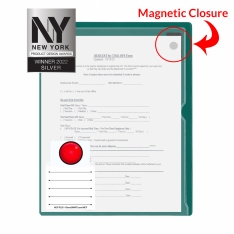A lifesaver that fits in your pocket
 From Street News Service A lifesaver that fits in your pocketStreet Roots - USA 18 July 2011 In Portland, USA, a little red bag is helping the homeless to stay alive. The Vial of Life has a list of medical illnesses, prescriptions, emergency contacts, allergies and blood type -- all to be available to medical staff in case of emergency. (934 Words) - By Stacy Brownhill 
The Vial of Life contains medical information that can help homeless people in case of emergency.Courtesy of the Downtown Chapel How much good can a small red pouch, zip tie and sheet of paper do for someone living on the streets? Turns out, a lot. Downtown Chapel is pioneering an innovative, potentially life-saving program for medically vulnerable people experiencing homelessness called the Vial of Life program. It's actually an adaptation of a nationally established program used by people who have homes, applied now to those who do not. Homeless participants can fill out a one-page sheet listing medical illnesses, prescriptions, emergency contacts, allergies and blood type, stuff it into a red plastic pouch no bigger than an index card, and attach it to their backpack. The "vial" provides an easily identifiable, relatively reliable record to emergency personnel, and Downtown Chapel keeps a copy in case the original is lost. Since June, around 40 homeless individuals have participated in the Vial of Life program at Downtown Chapel, meeting one-on-one for a few minutes with volunteer nursing students from University of Portland who help them fill out medical information and even call pharmacies if there are questions about prescriptions. Reviews by participants have been "over the moon," says Andrew Noethe, pastoral associate at Downtown Chapel who is overseeing the implementation of the Vial of Life program in collaboration with parish nurse Sharon Christenson. Participant Michelle says she recommends it to other friends on the street who have seizures or diabetes and thinks there should be "a lot more awareness" about the Vial of Life program. So far, people seem eager to sign up for the program. "When you're vulnerable and sick, you know it," says Michelle. Diabetes, seizures and cognitive disabilities are at the top of the list of health issues that the Vial of Life program hopes to track. The health record may be largely self-reported, but the volunteer nursing students at Downtown Chapel "help ask the right questions in a safe place," says Noethe. "Sometimes a participant will just open their bag and show a nurse all the pills they've been taking, and that's helpful if EMTs pick that person up," he says. Piloted with Northwest Parish Nurse Ministries and Providence Health Systems, the Vial of Life program is an enormous boon for homeless health care in Portland. People who are homeless are often mobile, without health insurance, especially vulnerable to injuries and illness, and prime candidates for reduced recollection, often the result of past trauma or head injuries. Emergency personnel, including EMTs, police and Central City Concern's CHIERS staff, are frequently forced to rely on guesswork when it comes to helping sick people on the streets. For instance, last year more than 8,400 inebriated people were picked up off the streets and taken to Hooper Sobering Center on NE Burnside and MLK. "One of the first questions asked is, 'do you have any medical conditions,'" says manager Steve Mattsson. But he admits that the homeless folks who come in are notoriously poor historians of medical history. Plus, alcohol can mask over many serious medical issues. "I meet first responders who wonder, 'did I make the right choice?'" says Noethe, who hopes the Vial of Life program will change that. "The bottom line is we need to make sure those in need - however that is defined - get the right help in an emergency," says Jean Marks with Providence Health & Service's Public Relations office. "Emergency responders seem to be excited about this program because it makes their job easier. They don't have to guess about their patients' allergies and prescriptions," says Marks. "It serves the poor and vulnerable, but it also helps everyone do a better job." Bruce Strade, executive director of Northwest Parish Nurse Ministries, says they are just getting a feel for how successful the program is, but thinks adapting the program for other agencies is "not out of our reach." Downtown Chapel's idea for the Vial of Life program originated from Northwest Parish Nurse Ministries' and Providence Health Systems' Vial of L.I.F.E. (Lifesaving Information for Emergencies) program - a traditional method of storing medical information of isolated elders' in readily identifiable pill bottles in refrigerators. Early this year, parish nurse Sharon Christenson asked, 'why not do this in the homeless community?' and approached Noethe with the idea of implementing the Vial of Life program at Downtown Chapel. Noethe says he immediately took to the idea, remembering times when homeless guests passed out mysteriously in Downtown Chapel's lobby. He is especially hopeful that the program will help guests with trauma history, including traumatic brain injuries, who cannot recall medical history. "They dont' always keep everything in mind," says Michelle, who is borderline diabetic combined with other medical issues. "And if (medics) don't know about it, that's a problem." Noethe agrees. "It is essential that first responders, especially in Old Town, are able to identify the Vial of Life pouches and make use of them," says Noethe. His plan forward is to replicate the Vial of Life program among other Portland service agencies. Noethe has even created a manual for other organizations to implement and evaluate the program. "I have no doubt this is going to benefit someone," says Noethe. "With Vial of Life, we're not doing case work where we follow people over time, and we won't always get to see the outcomes. "But I know this will improve lives." |





